实验3 类和对象_基础编程2
任务一:
源代码:
button.hpp

1 #pragma once 2 3 #include<iostream> 4 #include<string> 5 6 using std::string; 7 using std::cout; 8 9 //按钮类 10 class Button { 11 public: 12 Button(const string &text); 13 string get_label() const; 14 void click(); 15 16 private: 17 string label; 18 }; 19 20 Button::Button(const string &text): label {text} {} 21 22 inline string Button::get_label() const { return label;} 23 24 void Button::click() { 25 cout<<"Button '"<<label<<"' clicked\n"; 26 }
window.hpp

1 #pragma once 2 #include "button.hpp" 3 #include<vector> 4 #include<iostream> 5 6 using std::vector; 7 using std::cout; 8 using std::endl; 9 10 //窗口类 11 class Window { 12 public: 13 Window(const string &win_title); 14 void display() const; 15 void close(); 16 void add_button(const string &label); 17 18 private: 19 string title; 20 vector<Button> buttons; 21 }; 22 23 Window::Window(const string &win_title): title{win_title} { 24 buttons.push_back(Button("close")); 25 } 26 27 inline void Window::display() const { 28 string s(40,'*'); 29 30 cout<<s<<endl; 31 cout<<"window title:"<< title <<endl; 32 cout<<"It has "<<buttons.size()<<" buttons:"<<endl; 33 for(const auto &i: buttons) 34 cout<< i.get_label()<<" button"<<endl; 35 cout<< s << endl; 36 } 37 38 void Window::close() { 39 cout<<"close window ''"<<title<<"'"<<endl; 40 buttons.at(0).click(); 41 } 42 43 void Window::add_button(const string &label) { 44 buttons.push_back(Button(label)); 45 }
task1.cpp

1 #include"window.hpp" 2 #include<iostream> 3 4 using std::cout; 5 using std::cin; 6 7 void test() { 8 Window w1("new window"); 9 w1.add_button("maximize"); 10 w1.display(); 11 w1.close(); 12 } 13 14 int main() { 15 cout<<"用组合类模拟简单GUI:\n"; 16 test(); 17 }
运行结果:
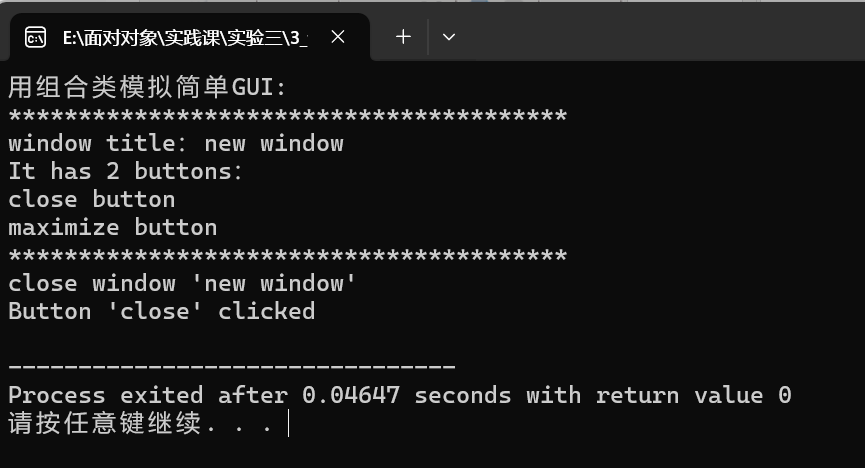
问题1:
自定义:按钮类Button、窗口类Window
标准库:vector动态数组类、 string类、iostream类
Window与Button存在组合关系。在 Window 类中,有一个成员变量 buttons ,其类型是 vector<Button>构成了组合关系。即 Window 类是由 string 类的title和vector<Button>类型的 buttons 等成员组成。
问题2:
不适合设置为inline:函数体较为复杂
不适合设置为const:1.构造函数主要用于初始化对象,对成员变量进行赋值修改
2.调用了非const的其他函数
3.函数涉及到输出操作改变了程序执行的状态
4.函数涉及到对动态分配内存的修改
问题3:
创建一个strin类型的对象s, 其中,40 表示字符的长度,即个数,'*'表示填充这个字符串的字符。所以,s是一个由40个'*'字符组成的字符串。
任务二:
task2

1 #include<iostream> 2 #include<vector> 3 4 using namespace std; 5 6 void output1(const vector<int> &v) { 7 for(auto &i:v) 8 cout<<i<<", "; 9 cout<<"\b\b \n"; 10 } 11 12 void output2(const vector<vector<int>> v) { 13 for(auto &i:v) { 14 for(auto &j:i) 15 cout<<j<<", "; 16 cout<<"\b\b \n"; 17 } 18 } 19 20 void test1() { 21 vector<int> v1(5,42); 22 const vector<int> v2(v1); 23 24 v1.at(0)=-999; 25 cout<<"v1;"; output1(v1); 26 cout<<"v2:"; output1(v2); 27 cout<<"v1.at(0) = " <<v1.at(0)<<endl; 28 cout<<"v2.at(0) = " <<v2.at(0)<<endl; 29 } 30 31 void test2() { 32 vector<vector<int>> v1{{1,2,3},{4,5,6,7}}; 33 const vector<vector<int>> v2(v1); 34 35 v1.at(0).push_back(-999); 36 cout<<"v1:\n"; output2(v1); 37 cout<<"v2:\n"; output2(v2); 38 39 vector<int> t1 = v1.at(0); 40 cout<<t1.at(t1.size()-1) << endl; 41 42 const vector<int> t2 = v2.at(0); 43 cout<< t2.at(t2.size()-1) <<endl; 44 } 45 46 int main() { 47 cout<<"测试1:\n"; 48 test1(); 49 cout<<"\n测试2:\n"; 50 test2(); 51 }
运行结果:
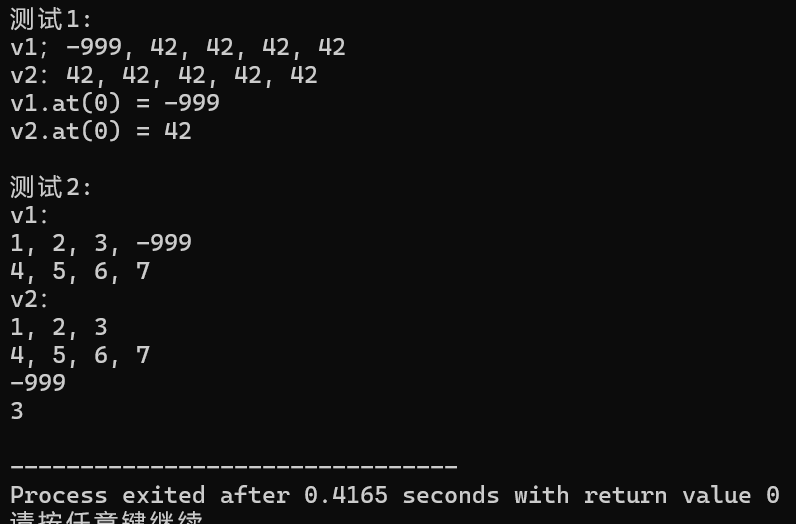
问题1:
vector<int> v1(5,42);
创建了一个名为 v1 的 vector 类型对象,v1 包含 5 个整数元素,都为 42。
const vector<int> v2(v1);
创建了一个新的 vector 类型对象 v2,通过将 v1 作为参数传递给 v2 的构造函数,将 v1 中的所有元素复制到 v2 中。
v1.at(0)=-999;
v1 向量的 at 成员函数,其目的是访问并修改 v1 向量中的第一个元素,通过 at(0) 定位到了 v1 向量中的第一个元素,然后将其值修改为 -999
问题2:
vector<vector<int>> v1{{1,2,3},{4,5,6,7}};
创建了一个名为 v1 的二维向量),其元素类型是 vector<int>,即每个元素又是一个整数向量。内层的两个大括号 {1,2,3} 和 {4,5,6,7} 表示创建两个vector<int>类型的子向量,并将它们作为元素添加到 v1 中。
const vector<vector<int>> v2(v1);
创建了一个新的二维向量 v2,其元素类型同样是vector<int>,通过将 v1 作为参数传递给 v2 的构造函数,实现了将 v1 中的所有元素(这里是两个子向量)复制到 v2 中。
v2被声明为 const,这意味着一旦 v2 被创建完成,它将是一个常量对象,不允许对其进行任何修改操作。
v1.at(0).push_back(-999);
v1 的 at 成员函数,这里的 at 函数用于访问二维向量 v1 中的元素。由于二维向量 v1 是 vector<vector<int>> 类型,,at(0) 表示定位到 v1 中的第一个子向量,也就是 [1, 2, 3]。
push_back 函数的作用是在向量的末尾添加一个新的元素。所以在这里,就是在第一个子向量 [1, 2, 3] 的末尾添加一个新元素 -999。
问题3:
vector<int> t1 = v1.at(0);
从二维向量 v1 中获取其第一个子向量(通过 at(0)),并将该子向量赋值给新创建的一维向量 t1。
cout<<t1.at(t1.size()-1) << endl;
输出一维向量 t1 中的最后一个元素的值,先通过 t1.size() - 1 确定最后一个元素的索引,再用 at 函数安全获取该元素并输出。
const vector<int> t2 = v2.at(0);
从常量二维向量 v2 中获取其第一个子向量(通过 at(0)),并将该子向量赋值给新创建的常量一维向量 t2。
cout<< t2.at(t2.size()-1) <<endl;
输出常量一维向量 t2 中的最后一个元素的值,同样先确定索引,再用 at 函数安全获取元素并输出。
问题4:
深复刻
是的。
任务三
vectorInt.hpp

1 #pragma once 2 3 #include<iostream> 4 #include<cassert> 5 6 using std::cout; 7 using std::endl; 8 9 //动态int数组对象类 10 class vectorInt{ 11 public: 12 vectorInt(int n); 13 vectorInt(int n,int value); 14 vectorInt(const vectorInt &vi); 15 ~vectorInt(); 16 17 int& at(int index); 18 const int& at(int index) const; 19 20 vectorInt& assign(const vectorInt &v); 21 int get_size() const; 22 23 private: 24 int size; 25 int *ptr; // ptr指向包含size个int的数组 26 }; 27 28 vectorInt::vectorInt(int n): size{n},ptr{new int[size]} { 29 } 30 31 vectorInt::vectorInt(int n,int value): size{n},ptr{new int[size]} { 32 for(auto i=0;i<size;++i) 33 ptr[i]=value; 34 } 35 36 vectorInt::vectorInt(const vectorInt &vi): size{vi.size},ptr{new int[size]} 37 { 38 for(auto i=0;i<size;++i) 39 ptr[i]=vi.ptr[i]; 40 } 41 42 vectorInt::~vectorInt() { 43 delete [] ptr; 44 } 45 46 const int& vectorInt::at(int index) const { 47 assert(index >= 0 && index < size); 48 49 return ptr[index]; 50 } 51 52 int& vectorInt::at(int index) { 53 assert(index >= 0 && index < size); 54 55 return ptr[index]; 56 } 57 58 vectorInt& vectorInt::assign(const vectorInt &v) { 59 delete[] ptr; //释放对象中ptr原来指向的资源 60 61 size = v.size; 62 ptr = new int[size]; 63 64 for(int i=0;i<size;++i) 65 ptr[i] = v.ptr[i]; 66 67 return *this; 68 } 69 70 int vectorInt::get_size() const { 71 return size; 72 }
task3.cpp

1 #include"vectorInt.hpp" 2 #include<iostream> 3 4 using std::cin; 5 using std::cout; 6 7 void output(const vectorInt &vi) { 8 for(auto i=0;i<vi.get_size();++i) 9 cout<<vi.at(i)<<", "; 10 cout<<"\b\b \n"; 11 } 12 13 void test1() { 14 int n; 15 cout<<"Enter n:"; 16 cin>>n; 17 18 vectorInt x1(n); 19 for(auto i=0;i<n;++i) 20 x1.at(i) = i*i; 21 cout<<"x1:"; output(x1); 22 23 vectorInt x2(n,42); 24 vectorInt x3(x2); 25 x2.at(0) = -999; 26 cout<<"x2:"; output(x2); 27 cout<<"x3:"; output(x3); 28 } 29 30 void test2() { 31 const vectorInt x(5,42); 32 vectorInt y(10,0); 33 34 cout<<"y:"; output(y); 35 y.assign(x); 36 cout<<"y:"; output(y); 37 38 cout<<"x.at(0) = "<<x.at(0)<<endl; 39 cout<<"y.at(0) = "<<y.at(0)<<endl; 40 } 41 42 int main() { 43 cout<<"测试1:\n"; 44 test1(); 45 46 cout<<"测试2:\n"; 47 test2(); 48 }
运行结果:
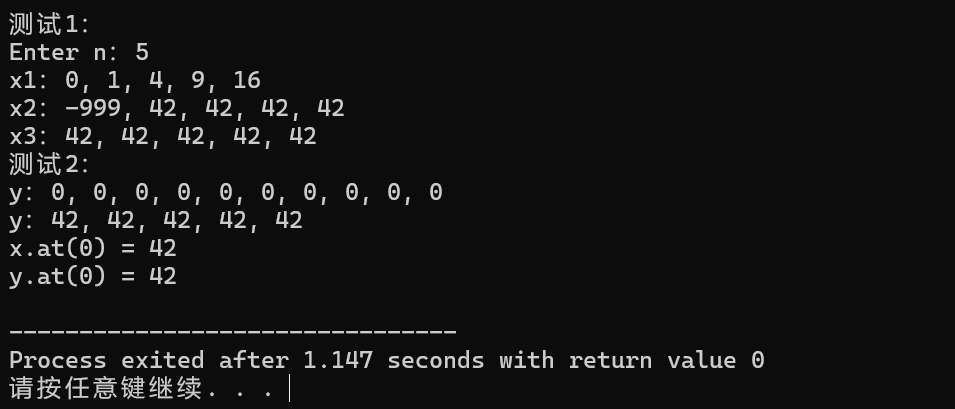
问题1:
深复制
问题2:
不能。
存在潜在安全隐患。当 at() 函数被定义为 const 时,它保证了在常量对象上调用该函数不会修改对象的状态。如果去掉了 line18 中返回值类型前面的 const,那么在 output 函数中调用 at() 函数时,虽然在当前代码实现中可能不会出现明显的错误,但从代码的规范性和安全性角度来看,就失去了对常量对象状态保护的约束。
问题3:
不可以,目前 assign() 接口的返回值类型是 vectorInt&,它返回的是当前对象本身的引用(通过 *this)。这样设计的好处是可以实现链式调用,比如在某些场景下可以连续对多个对象进行赋值操作。如果将返回值类型改成 vectorInt,那么函数返回的将是对象的副本而不是对象本身的引用。
任务四
matrix.hpp

1 #pragma once 2 3 #include <iostream> 4 #include <cassert> 5 6 using std::cout; 7 using std::endl; 8 9 // 类Matrix的声明 10 class Matrix { 11 public: 12 Matrix(int n, int m); // 构造函数,构造一个n*m的矩阵, 初始值为value 13 Matrix(int n); // 构造函数,构造一个n*n的矩阵, 初始值为value 14 Matrix(const Matrix &x); // 复制构造函数, 使用已有的矩阵X构造 15 ~Matrix(); 16 17 void set(const double *pvalue); // 用pvalue指向的连续内存块数据按行为矩阵赋值 18 void clear(); // 把矩阵对象的值置0 19 20 const double& at(int i, int j) const; // 返回矩阵对象索引(i,j)的元素const引用 21 double& at(int i, int j); // 返回矩阵对象索引(i,j)的元素引用 22 23 int get_lines() const; // 返回矩阵对象行数 24 int get_cols() const; // 返回矩阵对象列数 25 26 void display() const; // 按行显示矩阵对象元素值 27 28 private: 29 int lines; // 矩阵对象内元素行数 30 int cols; // 矩阵对象内元素列数 31 double *ptr; 32 }; 33 34 // 类Matrix的实现:待补足 35 // xxx 36 Matrix::Matrix(int n, int m) : lines{ n }, cols{ m } 37 { 38 ptr = new double[n * m]; 39 } 40 41 Matrix::Matrix(int n) :Matrix(n, n) {} 42 43 Matrix::Matrix(const Matrix& x) :lines{ x.lines }, cols{ x.cols } 44 { 45 ptr = new double[x.lines * x.cols]; 46 for (int i = 0; i < x.lines * x.cols; i++) 47 *(ptr + i) = *(x.ptr + i); 48 } 49 50 Matrix::~Matrix() = default; 51 52 void Matrix::set(const double* pvalue) 53 { 54 for (int i = 0; i < lines * cols; i++) 55 *(ptr + i) = *(pvalue + i); 56 } 57 58 void Matrix::clear() 59 { 60 for (int i = 0; i < lines * cols; i++) 61 *(ptr + i) = 0; 62 } 63 64 const double& Matrix::at(int i, int j) const 65 { 66 return *(ptr + i * cols + j); 67 } 68 69 double& Matrix::at(int i, int j) 70 { 71 return *(ptr + i * cols + j); 72 } 73 74 int Matrix::get_lines() const 75 { 76 return lines; 77 } 78 79 int Matrix::get_cols() const 80 { 81 return cols; 82 } 83 84 void Matrix::display() const 85 { 86 for (int i = 0; i < lines; i++) 87 { 88 for (int j = 0; j < cols; j++) 89 cout << *(ptr + i * cols + j) << ", "; 90 cout << "\b\b\n"; 91 } 92 }
task4.cpp

1 #include "matrix.hpp" 2 #include <iostream> 3 #include <cassert> 4 5 using std::cin; 6 using std::cout; 7 using std::endl; 8 9 10 const int N = 1000; 11 12 // 输出矩阵对象索引为index所在行的所有元素 13 void output(const Matrix &m, int index) { 14 assert(index >= 0 && index < m.get_lines()); 15 16 for(auto j = 0; j < m.get_cols(); ++j) 17 cout << m.at(index, j) << ", "; 18 cout << "\b\b \n"; 19 } 20 21 22 void test1() { 23 double x[1000] = {1, 2, 3, 4, 5, 6, 7, 8, 9}; 24 25 int n, m; 26 cout << "Enter n and m: "; 27 cin >> n >> m; 28 29 Matrix m1(n, m); // 创建矩阵对象m1, 大小n×m 30 m1.set(x); // 用一维数组x的值按行为矩阵m1赋值 31 32 Matrix m2(m, n); // 创建矩阵对象m1, 大小m×n 33 m2.set(x); // 用一维数组x的值按行为矩阵m1赋值 34 35 Matrix m3(2); // 创建一个2×2矩阵对象 36 m3.set(x); // 用一维数组x的值按行为矩阵m4赋值 37 38 cout << "矩阵对象m1: \n"; m1.display(); cout << endl; 39 cout << "矩阵对象m2: \n"; m2.display(); cout << endl; 40 cout << "矩阵对象m3: \n"; m3.display(); cout << endl; 41 } 42 43 void test2() { 44 Matrix m1(2, 3); 45 m1.clear(); 46 47 const Matrix m2(m1); 48 m1.at(0, 0) = -999; 49 50 cout << "m1.at(0, 0) = " << m1.at(0, 0) << endl; 51 cout << "m2.at(0, 0) = " << m2.at(0, 0) << endl; 52 cout << "矩阵对象m1第0行: "; output(m1, 0); 53 cout << "矩阵对象m2第0行: "; output(m2, 0); 54 } 55 56 int main() { 57 cout << "测试1: \n"; 58 test1(); 59 60 cout << "测试2: \n"; 61 test2(); 62 }
运行结果:
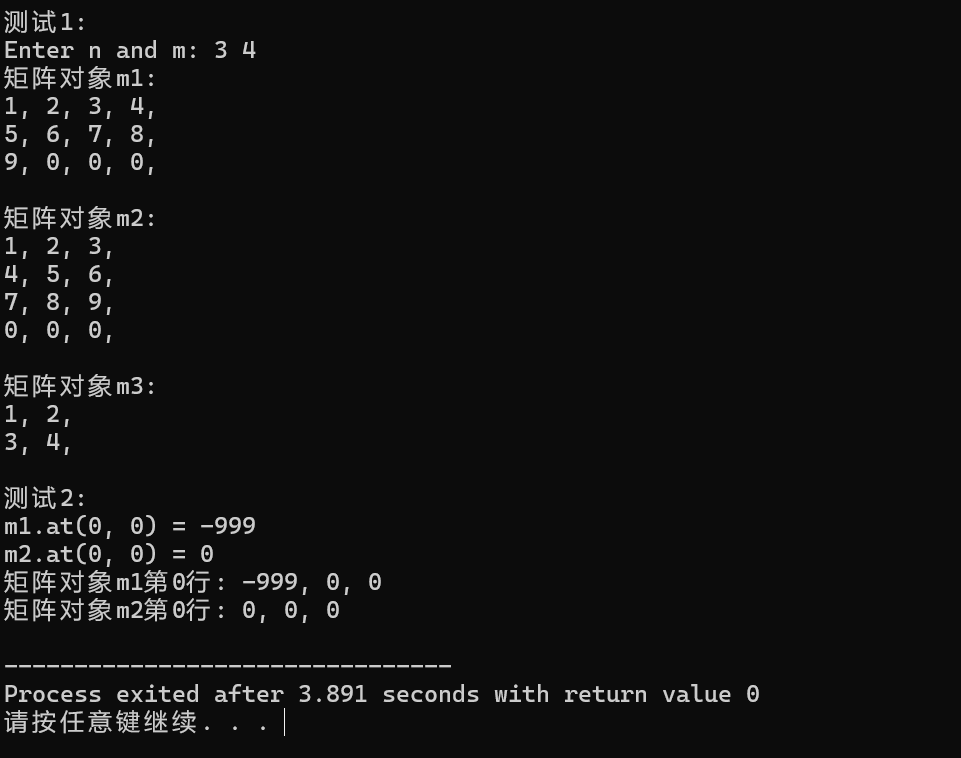
任务五:
user.hpp

1 #pragma once 2 3 #include<iostream> 4 #include<string> 5 6 using std::string; 7 using std::cout; 8 using std::cin; 9 using std::endl; 10 11 class User { 12 public: 13 User(const string Name,string Password = "123456",string Email= ""): name{Name},password{Password},email{Email} {} 14 void set_email(); 15 void change_password(); 16 const void display(); 17 18 private: 19 string name; 20 string password; 21 string email; 22 }; 23 24 void User::set_email() { 25 cout<<"Enter email address:"; 26 27 while(1) { 28 string temp; 29 cin>>temp; 30 if(temp.find('@') != -1) { 31 cout<<"email is set successfully..."<<endl; 32 email = temp; 33 break; 34 } 35 else 36 cout<<"illegal email.Please re-enter email:"; 37 } 38 } 39 40 void User::change_password() { 41 int count = 0; 42 string oldpassword; 43 string newpassword; 44 cout<<"Enter old password:"; 45 for(count = 0;count<3;count++) 46 { 47 cin>>oldpassword; 48 if(oldpassword != password) { 49 cout<<"password input error."; 50 if(count==2) { 51 cout<<"Please try after a while."<<endl; 52 } 53 else { 54 cout<<"Please re-enter again:"; 55 } 56 } 57 else { 58 cout<<"Enter new password:"; 59 cin>>newpassword; 60 password = newpassword; 61 cout<<"new password is set successfully..."<<endl; 62 break; 63 } 64 } 65 } 66 67 const void User::display() { 68 string temp(password.size(),'*'); 69 70 cout<<"name:"<<name<<endl; 71 cout<<"password:"<< temp <<endl; 72 cout<<"email:" << email <<endl; 73 }
task5.cpp

1 #include "user.hpp" 2 #include <iostream> 3 #include <vector> 4 #include <string> 5 6 using std::cin; 7 using std::cout; 8 using std::endl; 9 using std::vector; 10 using std::string; 11 12 void test() { 13 vector<User> user_lst; 14 15 User u1("Alice", "2024113", "Alice@hotmail.com"); 16 user_lst.push_back(u1); 17 cout << endl; 18 19 User u2("Bob"); 20 u2.set_email(); 21 u2.change_password(); 22 user_lst.push_back(u2); 23 cout << endl; 24 25 User u3("Hellen"); 26 u3.set_email(); 27 u3.change_password(); 28 user_lst.push_back(u3); 29 cout << endl; 30 31 cout << "There are " << user_lst.size() << " users. they are: " << endl; 32 for (auto& i : user_lst) { 33 i.display(); 34 cout << endl; 35 } 36 } 37 38 int main() { 39 test(); 40 }
运行结果:
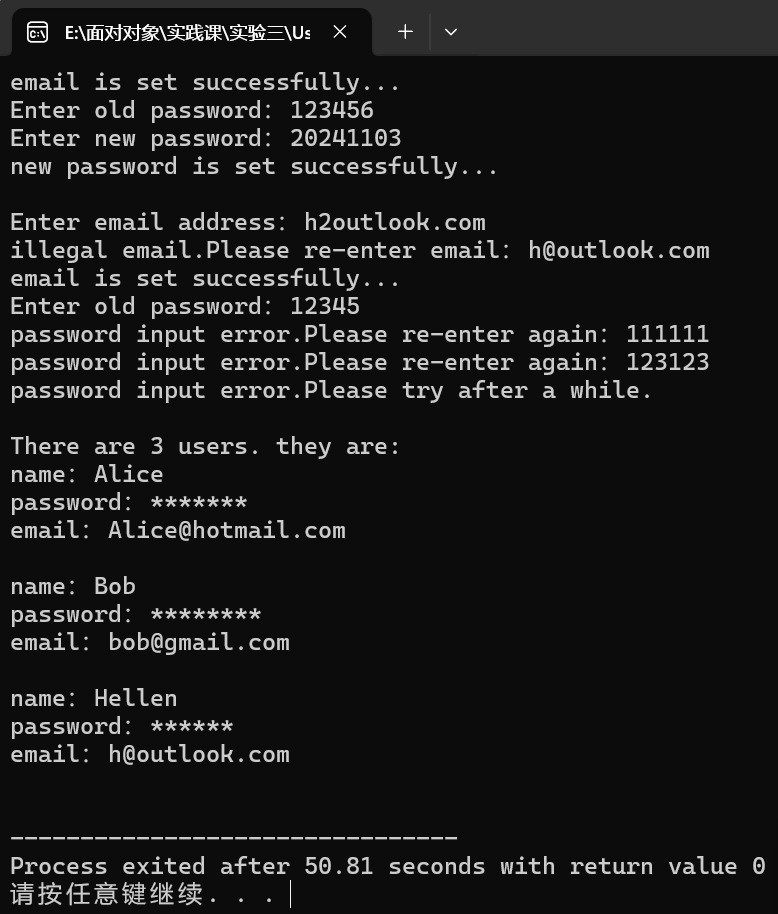
任务六:
date.h

1 #pragma once 2 #ifndef DATE H 3 #define DATE H 4 class Date { 5 private: 6 int year; 7 int month; 8 int day; 9 int totalDays; 10 public: 11 Date(int year, int month, int day); 12 int getYear()const { return year; } 13 int getMonth()const { return month; } 14 int getDay()const { return day; } 15 int getMaxDay()const; 16 bool isLeapYear()const { 17 return year % 4 == 0 && year % 100 != 0 || year % 400 == 0; 18 } 19 void show()const; 20 int distance(const Date& date)const { 21 return totalDays - date.totalDays; 22 } 23 }; 24 #endif //DATE H
date.cpp

1 #include"date.h" 2 #include<iostream> 3 #include<cstdlib> 4 using namespace std; 5 namespace { 6 const int DAYS_BEFORE_MONTH[] = { 0,31,59,90,120,151,181,212,243,273,304,334,365 }; 7 } 8 Date::Date(int year, int month, int day) :year{ year }, month{ month }, day{ day } { 9 if (day <= 0 || day > getMaxDay()) { 10 cout << "Invalid date:"; 11 show(); 12 cout << endl; 13 exit(1); 14 } 15 int years = year - 1; 16 totalDays = years * 365 + years / 4 - years / 100 + years / 400 + DAYS_BEFORE_MONTH[month - 1] + day; 17 if (isLeapYear() && month > 2)totalDays++; 18 } 19 int Date::getMaxDay()const { 20 if (isLeapYear() && month == 2) 21 return 29; 22 else 23 return DAYS_BEFORE_MONTH[month] - DAYS_BEFORE_MONTH[month - 1]; 24 } 25 void Date::show()const { 26 cout << getYear() << "-" << getMonth() << "-" << getDay(); 27 }
account.h

1 #pragma once 2 #ifndef ACCOUNT H 3 #define ACCOUNT H 4 #include"date.h" 5 #include<string> 6 class SavingsAccount { 7 private: 8 std::string id; 9 double balance; 10 double rate; 11 Date lastDate; 12 double accumulation; 13 static double total; 14 15 void record(const Date& date, double amount, const std::string& desc); 16 17 void error(const std::string& msg)const; 18 19 double accumulate(const Date& date)const { 20 return accumulation + balance * date.distance(lastDate); 21 } 22 public: 23 SavingsAccount(const Date& date, const std::string& id, double rate); 24 const std::string& getId()const { return id; } 25 double getBalance()const { return balance; } 26 double getRate()const { return rate; } 27 static double getTotal() { return total; } 28 29 void deposit(const Date& date, double amount, const std::string& desc); 30 31 void withdraw(const Date& date, double amount, const std::string& desc); 32 33 void settle(const Date& date); 34 35 void show()const; 36 }; 37 #endif// ACCOUNT H
account.cpp

1 #include"account.h" 2 #include<iostream> 3 #include<cmath> 4 using namespace std; 5 double SavingsAccount::total = 0; 6 7 SavingsAccount::SavingsAccount(const Date& date, const string& id, double rate) :id{ id }, balance{ 0 }, rate{ rate }, lastDate{ date }, accumulation{ 0 } { 8 date.show(); 9 cout << "\t#" << id << "created" << endl; 10 } 11 12 void SavingsAccount::record(const Date& date, double amount, const string& desc) { 13 accumulation = accumulate(date); 14 lastDate = date; 15 amount = floor(amount * 100 + 0.5) / 100; 16 balance+= amount; 17 total += amount; 18 date.show(); 19 cout << "\t#" << id << "\t" << amount << "\t" << balance << "\t" << desc << endl; 20 } 21 22 void SavingsAccount::error(const string& msg)const { 23 cout << "Error(#" << id << "):" << msg << endl; 24 } 25 26 void SavingsAccount::deposit(const Date& date, double amount, const string& desc) { 27 record(date, amount, desc); 28 } 29 30 void SavingsAccount::withdraw(const Date& date, double amount, const string& desc) { 31 if (amount > getBalance()) 32 error("not enough money"); 33 else 34 record(date, -amount, desc); 35 } 36 37 void SavingsAccount::settle(const Date& date) { 38 double interest = accumulate(date) * rate / date.distance(Date(date.getYear() - 1, 1, 1)); 39 if (interest != 0) 40 record(date, interest, "interest"); 41 accumulation = 0; 42 } 43 44 void SavingsAccount::show()const { 45 cout << id << "\tBalance:" << balance; 46 }
6_25.cpp

1 #include"account.h" 2 #include<iostream> 3 using namespace std; 4 int main() { 5 Date date(2008, 11, 1); 6 7 SavingsAccount accounts[] = { 8 SavingsAccount(date,"03755217",0.015),SavingsAccount(date,"02342342",0.015) 9 }; 10 const int n = sizeof(accounts) / sizeof(SavingsAccount); 11 12 accounts[0].deposit(Date(2008, 11, 5), 5000, "salary"); 13 accounts[1].deposit(Date(2008, 11, 25), 10000, "sell stock 0323"); 14 15 accounts[0].deposit(Date(2008, 12, 5), 5500, "salary"); 16 accounts[1].withdraw(Date(2008, 12, 20), 4000, "buy a laptop"); 17 18 cout << endl; 19 for (int i = 0; i < n; i++) { 20 accounts[i].settle(Date(2009, 1, 1)); 21 accounts[i].show(); 22 cout << endl; 23 } 24 cout << "Total:" << SavingsAccount::getTotal() << endl; 25 return 0; 26 }
运行结果:
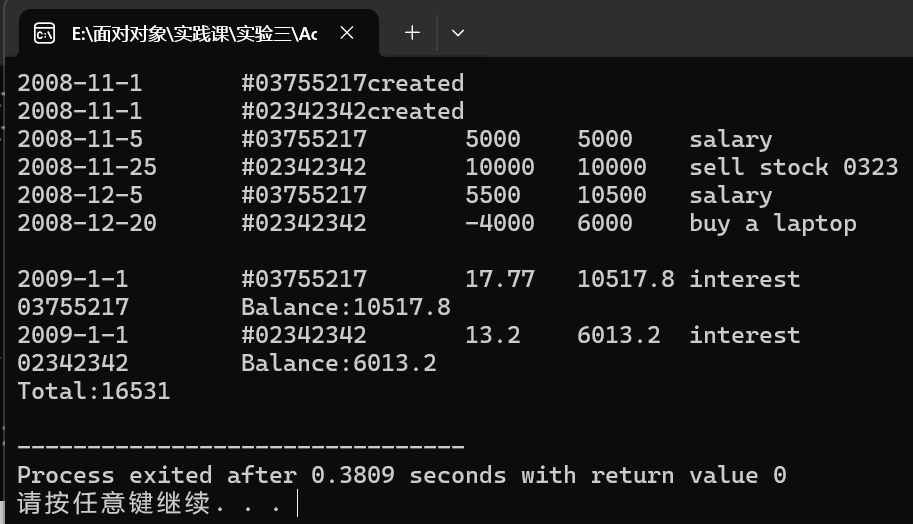
实验总结:
1.
通过模拟 GUI 的窗口和按钮示例,深刻理解了类之间的组合关系(has-a 关系)。例如,Window类中包含了vector<Button>类型的成员变量,表明一个窗口拥有多个按钮,这种组合方式能很好地模拟现实世界中对象的构成关系。
构造函数要点:在定义组合类的构造函数时,要注意对所包含对象的初始化。如Window类的构造函数中,不仅初始化了自身的title成员变量,还会默认添加一个Button对象到buttons向量中。
2.
标准库vector的复制构造函数实现的是深复制,保证了新对象与原对象在内存中的独立性;而自定义vectorInt类在实现复制构造函数时,通过重新分配内存并逐个复制元素的方式实现深复制,避免了浅复制可能导致的对象间数据相互影响的问题。
明白了在需要对对象进行修改而不影响原始对象的情况下,深复制是必要的。比如在函数传参过程中,如果不希望在函数内部对传入的对象修改影响到外部的原始对象,就应采用深复制方式传递对象。




